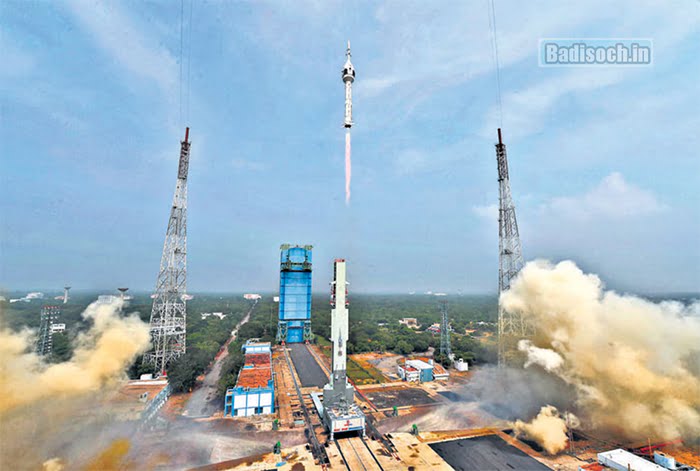Gaganyaan Test Flight : The Indian Space Research Organisation (ISRO) has announced that the Gaganyaan spacecraft test will take place on October 21, 2023, at Sriharikota, Andhra Pradesh between 7 am to 9 am. The test is a crucial step for India’s space exploration ambitions and marks a significant milestone in its journey towards becoming a leader in space technology. The success of this mission will demonstrate ISRO’s technical capabilities and commitment to pushing the boundaries of space exploration. It will also showcase India’s unwavering dedication to advancing its space program and exploring new frontiers. With this mission, India joins an elite group of nations capable of carrying humans into space.
The dream of sending humans to space is closer than ever before. With the successful completion of the Gaganyaan Test Flight, India has taken a giant leap towards becoming the fourth country to send astronauts into space. In this blog post, we will delve into the details of this historic mission, exploring the technology behind Gaganyaan and the significance of this achievement for India’s space program. So, buckle up and get ready to embark on an extraterrestrial adventure as we explore the exciting world of space exploration!
Gaganyaan Test Flight
India’s Gaganyaan Test Flight project aims to demonstrate the country’s capability to launch humans into a 400-kilometer orbit and safely return them to Earth with a splashdown in the Bay of Bengal. The project is currently focused on evaluating the crew module in preparation for the upcoming trip next year. This test flight is an important step toward India’s goal of becoming a major player in space exploration, and it will pave the way for future manned missions to space. The successful completion of this mission will also put India in an elite group of countries that have sent humans into space, including Russia, China, and the United States.
The upcoming Gaganyaan test mission will involve sending a spacecraft into space and then safely returning it to Earth. The spacecraft will be recovered following a landing in the Bay of Bengal. The Indian Space Research Organisation (ISRO) has designed an unpressurized Command Module (CM) for this mission, which has undergone rigorous integration and testing. The CM is equipped with advanced instrumentation to record flight data, which will be used to evaluate the effectiveness of various technologies employed during the mission. This test mission marks a significant milestone for India’s space program and showcases its growing capabilities in space exploration and technology development.
Gaganyaan Test Flight Details
| Spacecraft name | Gangyaan Mission |
| Manufacturer | DRDO, HAL, ISRO |
| Country | India |
| Operator | ISRO |
| Gaganyan Mission 2023 Launch Date | 21 October 2023 |
| Place | Satish Dhawan Space Craft Center |
| Spacecraft type | Crewed |
| Launch mass | 8200 kg |
| Dry mass | 3735 kg |
| Crew capacity | 3 |
| Volume | 8 M |
| Power | Photovoltaic array |
| Category | News |
| Official Website | Click Here |
 |
|
| Telegram |
Also Check: School Assembly News Headlines Today 2023
Crew Module in Gaganyaan Mission
The Gaganyaan mission involves housing passengers in the Crew Module (CM), which is designed to replicate the atmospheric conditions on Earth. Currently, the CM for the Gaganyaan mission is undergoing various stages of development. The unpressurized version of the CM has undergone integration and testing and is now ready to be transported to the launch facility for the Test Vehicle Abort mission-1. It is important to note that the CM plays a crucial role in ensuring passenger safety during space missions and requires extensive testing and development before launch.
The unpressurized CM variation of Gaganyaan must have the same size and weight as the genuine CM, and it should include all the mechanisms necessary for acceleration and recovery. This includes a complete supply of fireworks, recovery aids, and jumps to ensure safe and successful return of the spacecraft. It is essential to ensure that the unpressurized CM variant is designed with precision to meet all the necessary requirements for a successful space mission. The safety and success of astronauts depend on meticulous planning and execution in every aspect of the spacecraft design.
Check Here: Upcoming Elections in India 2023-24
Human rated LVM3 – HLVM3 for Gaganyaan
The LVM3 rocket has been selected as the launch vehicle for the Gaganyaan mission. It is a heavy-lift rocket developed by ISRO and has a proven track record of reliability. The rocket has three stages, namely, solid, liquid, and cryogenic, which ensure efficient performance. The LVM3 launch vehicle has been upgraded to comply with human rating standards and is now referred to as Human Rated LVM3. Furthermore, it can launch the Orbital Module up to 400 km Low Earth Orbit. These upgrades demonstrate ISRO’s commitment to ensuring astronaut safety during the Gaganyaan mission.
The HLVM3’s Crew Escape System (CES) ensures that in the event of an incident at the launch site or during the descent phase, both the Crew Module and crew are safely transported to a suitable location. The CES operates using a series of solid motors with quick-acting and high-burn-rate capabilities, as demonstrated in the ISRO Gaganyan test flight Mission 2023. The primary objectives of the Gaganyaan Mission are to advance science and technology, as well as to inspire young individuals to pursue careers in these fields.
- It is a human-related launch vehicle since it can accommodate three astronauts.
- Crew module and service module of a habitable orbital module.
- support system for life
- If there is a problem with the spacecraft, the crew can use the crew escape mechanism to return to Earth.
- Choosing the crew and their duties
Look Here: ideaForge Technology IPO GMP Today
Orbital Module of Gaganyaan
The orbital module (OM) consists of the Crew Module (CM) and Service Module (SM), which will be orbiting Earth. The OM features modern avionics systems that offer adequate redundancy for human safety. The CM serves as the crew’s living quarters, and it has an environment that is comparable to Earth. Its double-walled building design comprises a pressurized metal inner structure and an unpressurized exterior framework with a Thermal Protective System (TPS). This design allows for maximum protection against extreme temperatures and other environmental hazards. Together, the CM and SM are integral components of the spacecraft that enable safe human spaceflight and scientific research in space.
The spacecraft module boasts a range of features, including avionics, life support, crew connections, centered around people goods, and brake systems. In addition to this, it is also designed for re-entry to ensure the safety of the crew during descent and landing. The service module (SM) will provide the necessary support to the command module (CM) while in orbit. The pressurized but unpressurized structure houses thermal, propulsion, power, avionics, and deployment mechanisms. These features work together to make the spacecraft module a reliable and safe mode of transportation for space exploration missions.
Read More: श्रीकृष्ण जन्माष्टमी पर आपको सपरिवार हार्दिक बधाई
Conclusion
The conclusion of the Gaganyaan test flight marks a significant milestone in India’s space exploration journey. The successful launch and safe return of the crew module demonstrate the country’s capabilities in manned space missions. This test flight not only brings India one step closer to realizing its ambition of sending astronauts into space but also lays the foundation for future endeavors in human spaceflight. The data gathered from this mission will be crucial in fine-tuning the design and systems of the spacecraft, ensuring that it is ready for future manned missions. With each successful test flight, India solidifies its position as a major player in the field of space exploration and paves the way for a new era of scientific discovery and technological advancement.
Also Check- SASSA Status Check August 2023
Gaganyaan Test Flight FAQ’S
When was the Gaganyaan test launched?
The first test flight of the 'TV-D1' (Test Vehicle Development Flight 1) in the Gaganyaan Mission was successfully conducted by ISRO on Saturday, 21 October. The test took place at the Satish Dhawan Space Centre (SDSC) in Sriharikota, Andhra Pradesh. However, the initial attempt had to be aborted at 8:45 am due to an engine ignition issue.
Where is Gaganyaan mission going?
India's space exploration aspirations are set to take off with Gaganyaan, which will be followed by a series of ambitious missions. One such mission is the objective to send humans to the Moon by 2040. Following the successful Test Vehicle-D1 (TV-D1) mission on October 21, the Indian Space Research Organisation (ISRO) has planned additional test missions in the coming months for the Gaganyaan program.
Is Gaganyaan Mission successful?
After initially aborting it, ISRO accomplished a significant milestone on Saturday by conducting a successful Test Flight Abort Mission for the Gaganyaan mission.
What is Indian Mission Gaganyaan?
ISRO aims to send humans into space on a Low Earth Orbit of 400 km for a three-day mission and bring them safely back to earth. Unlike previous missions undertaken by ISRO, this launch involves the Test Vehicle (TV-D1), a single-stage liquid propulsion rocket.
Related Posts:-
